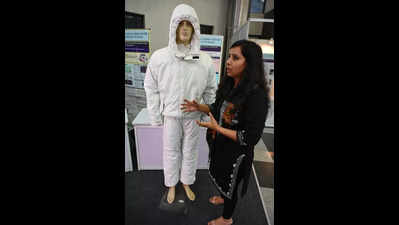New Delhi: The Advanced Ballistics for High-Energy Defeat bullet-resistant jacket, ABHED for shot, is among the lightest in the world but capable of withstanding multiple gunshots. “It can stop six to eight sniper bullets and it is 2.5 kg lighter than jackets currently available. Imagine a soldier climbing a slope in Siachen, where every gram counts. This jacket will significantly improve both efficiency and mobility,” said its developer professor Naresh Bhatnagar.
The ABHED jacket is among the extreme cold-weather clothing, anti-mine boots, flexible armour and other defence necessities developed through home-grown research now on show at the Indian National Academy of Engineering’s three-day annual convention, which began at IIT Delhi on Thursday. Essential gear for soldiers stationed in sub-zero environments are also featured. “These products are extremely crucial but we’ve needed to import them for at least four decades,” said Bhatnagar.
A key product in this regard is the newly developed lightweight, four-layered snowsuit designed to perform even in temperatures as low as -60°C. “The innermost layer is antimicrobial and retains its properties even after 30 washes,” said Dr Ranjana, project scientist at IIT Delhi, who worked under the guidance of professor R S Rengasamy. “The second layer is made of fleece, while the next two layers are insulation jackets. The outer layer is both waterproof and windproof. If everything goes well, we plan to send 15-20 of these suits to Siachen for our soldiers.”
The development team has not only focused on protecting soldiers in extreme cold but has also created heat protection clothing for fire suppression and rescue operations in enclosed spaces. They have also designed lightweight, flexible armour using ballistic textile materials, smart fluids and compressible structures to minimise blunt trauma.
The researchers are also exploring advancements in optical and nanomaterial technologies, especially for mirrors and optical surfaces. “The technology reduces the time needed to produce ophthalmic equipment and offers improvements in accuracy. This tech has applications in the automobile and defence industries as well,” said Avijit Prakash, PhD scholar at IIT-D.
Speaking at the inaugural session on Thursday, defence minister Rajnath Singh emphasised the need for scientists and engineers to gain expertise in emerging technologies. “Modern warfare is changing rapidly. Therefore, there is a need to adopt high-end technology,” he said. Technology transfer and the signing of various memoranda of agreements with various industry partners for the indigenisation of defence technologies marked the event.
Spearheaded by IIT-D teachers and with the active coordination of several Defence Research and Development Organisation laboratories and Indian industries, DRDO Industry Academia-Centre of Excellence (DIA-CoE) is addressing some of the niche technologies for the “soldier-in-the-field”. Almost 100 faculty members, 200 research scholars, and staff members are involved.
The convention, being attended by engineers and technologists, teachers and researchers from academia, industry, R&D organisations and strategic sector units, serves as a platform for networking and knowledge-sharing, with panel discussions and plenary talks by leading experts in various fields.




